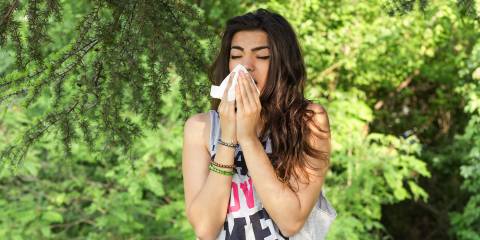Is hot, humid, and hazy weather making your hair so frizzy it has its own zipcode?
Take heart. Take a deep breath. And then take these steps.
Prevent Summer Hair Disasters
The cuticle, the outer layer of the hair shaft, is made up of overlapping cells that resemble shingles or scales. When the hair is healthy, the cuticle lies flat, giving hair a shiny, smooth look. But when the hair is subjected to UV light, chemical processing, or a dry environment, the cells of the cuticle are pulled up, leaving parts of the hair shaft exposed and weak.
Harsh, synthetic ingredients may worsen your hair’s condition. Look for shampoos and conditioners that contain nourishing ingredients, including:
- aloe, calendula, henna, and chamomile
- the amino acids cystine, cysteine, and methionine, which keep the layers of the cuticle flat, so the shaft of the hair remains protected
- soy and wheat proteins, as well as avocado oil and panthenol (vitamin B5)
- PABA, oxybenzone, titanium dioxide, and benzophenone are natural sunscreens that can prevent hair from becoming burnt and dry.
The Antifrizz Patrol
Very dry hair appears frizzy, so you need to moisturize. Some shampoos contain ingredients that can strip hair of its natural oils, which leads to dryness and frizz.
If your shampoo has this effect, try cleansing your hair with only conditioner to clean without drying out. Use the conditioner as you would shampoo: Scrub your hair and scalp, then rinse.
Or, after a shower, comb a leave-in conditioner through hair to protect it from chlorine and other pollutants.
Hair that needs extra attention due to blow-drying or styling procedures may respond well to a weekly hot oil treatment. Look for products that contain a light vegetable oil and apply just enough to coat your hair.
More Tips for Frizzy Hair
- Shower with warm (not hot) water when shampooing; one soaping is plenty.
- Avoid blow-drying. Intense heat can singe the hair shaft, making it harder to achieve a sleek look. If you must blow-dry, use a low setting or a diffuser.
- Take a break from hot irons and electric curlers.
- Wear a broad-brimmed hat outdoors. Consider a bathing cap when you swim.
- Braid your hair if it’s long enough to help control frizz.
Get Rid of Green
Too much chlorine from pools can compromise the structure of the hair, destroy its pigment and natural oils, and produce a chemical buildup on the shaft of the hair.
A coating of chlorine dries the hair and, if enough residue builds up, can even make light hair look green.
To remove chlorine residue, use a clarifying shampoo. Look for citric acid and molasses or corn syrup in the ingredients list. Molasses and corn syrup bond to the chlorine molecules while the citric acid pulls the molecules from the shaft.
Also look for products that contain botanicals like sage, lemon verbena, and myrrh, as well as tea tree and rosemary to help remove chlorine or salt water buildup. Herbs including lavender, ginkgo, yarrow, and goldenseal can also help rejuvenate hair.
Nutrition for Shiny Hair
What you eat affects the health of your hair.
Vitamin B5
Foods high in pantothenic acid (vitamin B5) support strong tresses, including:
- beans
- bran
- brown rice
- wheat germ
- brewer’s yeast
- cheese
- eggs
- fish
Oats, apples, honey, sunflower seeds, and avocados are good sources of sulfur, an essential nutrient for healthy hair.
Consider supplements that support a healthy head of hair, such as B complex. Vitamins A and C and the mineral zinc are necessary to regulate your hair’s natural oils.




